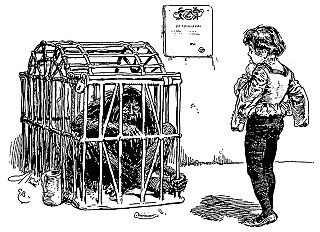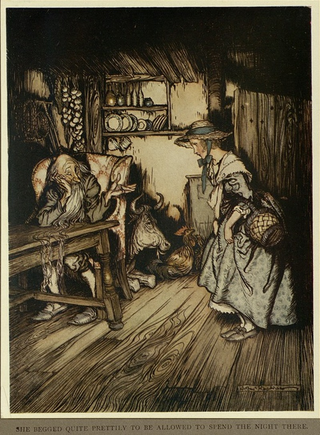Related Research Articles

"Iron John" is a German fairy tale found in the collections of the Brothers Grimm, tale number 136, about an iron-skinned wild man and a prince. The original German title is Eisenhans, a compound of Eisen "iron" and Hans. It represents Aarne–Thompson type 502, "The wild man as a helper".
"The Three Princesses of Whiteland" is a Norwegian fairy tale, collected by Norwegian writers Peter Christen Asbjørnsen and Jørgen Moe in their collection of folktales and legends Norske folkeeventyr (1879). Scottish poet and novelist Andrew Lang collected it his The Red Fairy Book (1890).

"The Hut in the Forest" is a German fairy tale collected by the Brothers Grimm. Andrew Lang included it in The Pink Fairy Book (1897). It is Aarne-Thompson type 431.
How the Dragon was Tricked is a Greek fairy tale collected by Johann Georg von Hahn in Griechische und Albanesische Märchen with the title Von dem Schönen und vom Drakos, and sourced from Kukuli. Andrew Lang included it in The Pink Fairy Book. It is Aarne-Thompson type 328, the boy steals the giant's treasures.

The Prince Who Worked as Satan's Servant and Saved the King from Hell is a Lithuanian fairy tale collected by German linguists August Leskien and Karl Brugmann. Andrew Lang included it in The Grey Fairy Book under the title The Magician's Horse.
The Story of Zoulvisia is an Armenian fairy tale published in Hamov-Hotov, a collection of Armenian fairy tales by ethnologue and clergyman Karekin Servantsians published in 1884. Andrew Lang included it in The Olive Fairy Book. The story was also featured in the book Once Long Ago, by Roger Lancelyn Green and illustrated by Vojtech Kubasta.
Molly Whuppie is an English language fairy tale set in Scotland. It was first published in 'Three Folk-Tales from Old Meldrum, Aberdeenshire' in "Folklore" (6.2.1884). Rev. Walter Gregor said that the tales had been 'communicated to me by Mr. Moir, Rector of the Grammar School, Aberdeen. He had them from his mother, who kindly wrote out " Mally Whuppie " and " The Red Calf" at my request.' Anglicising the name to "Molly" from "Mally" Joseph Jacobs used this source of the story in his English Fairy Tales. A Highland version, Maol a Chliobain, was collected by John Francis Campbell in Popular Tales of the West Highlands. Jacobs noted the relationship between the two tales, and an Irish variant, "Smallhead," and concluded that the tale was Celtic in origin.

"The Water of Life" is a German fairy tale collected by the Brothers Grimm, tale number 97.

The Black Thief and Knight of the Glen is an Irish fairy tale collected in Hibernian Tales. Andrew Lang included it in The Red Fairy Book.

The Sea-Maiden is a Scottish fairy tale collected by John Francis Campbell in Popular Tales of the West Highlands, listing his informant as John Mackenzie, fisherman, near Inverary. Joseph Jacobs included it in Celtic Fairy Tales.
"The Brown Bear of the Green Glen" is a Scottish fairy tale collected by John Francis Campbell in Popular Tales of the West Highlands, listing his informant as John MacDonald, a "Traveling Tinker". He also noted the parallels with The Water of Life.
"The King of Lochlin's Three Daughters" is a Scottish fairy tale collected by John Francis Campbell in his Popular Tales of the West Highlands, listing his informant as Neill Gillies, a fisherman near Inverary.

The King of England and his Three Sons is a Romani fairy tale collected by Joseph Jacobs in More English Fairy Tales. He listed as his source Francis Hindes Groome's In Gypsy Tents, where the informant was John Roberts, a Welsh Roma. Groome published the tale as An Old King and his three Sons in England.
"Niels and the Giants" is a Danish fairy tale. Andrew Lang included it in The Crimson Fairy Book.

"Tsarevich Ivan, the Firebird and the Gray Wolf" is a Russian fairy tale collected by Alexander Afanasyev in Russian Fairy Tales.
The Enchanted Watch is a French fairy tale collected by Paul Sébillot (1843–1918). Andrew Lang included it in his The Green Fairy Book (1892).
The Flea is an Italian literary fairy tale written by Giambattista Basile in his 1634 work, the Pentamerone.

The Norka is a Russian and Ukrainian fairy tale published by Alexander Afanasyev in his collection of Russian Fairy Tales, numbered 132.
Prâslea the Brave and the Golden Apples is a Romanian fairy tale collected by Petre Ispirescu in Legende sau basmele românilor.

"The Gnome" is a German fairy tale collected by the Brothers Grimm in Grimm's Fairy Tales, tale number 91.
References
- ↑ Uther, Hans-Jörg (2004). The Types of International Folktales: Animal tales, tales of magic, religious tales, and realistic tales, with an introduction. FF Communications. p. 592.
- ↑ Thompson, Stith (1977). The Folktale. University of California Press. p. 179. ISBN 978-1162917306.
- ↑ Zirag, Csenge. "C is for Caring fathers". The Multicolored Diary. Retrieved 14 January 2022.
- ↑ Halpert, Herbert; Widdowson, J. D. A. (1996). Folktales of Newfoundland: The Resilience of the Oral Tradition. Garland Publishing, Inc. p. 578.
- ↑ Uther, Hans-Jörg (2004). The Types of International Folktales: Animal tales, tales of magic, religious tales, and realistic tales, with an introduction. FF Communications. p. 592.
- ↑ de Alta Silva, Johannes; Gilleland, Bray (1981). Dolopathos, or, The King and the Seven Wise Men. Binghamton, New York: Center for Medieval and Early Renaissance Studies. pp. 62–68. ISBN 0-86698-006-7.
- ↑ Zipes, Jack. The Complete Fairy Tales of the Brothers Grimm. 2003.
- ↑ Jacobs, Joseph (1892). Celtic Fairy Tales. London: David Nutt. pp. 34–46.
- ↑ Richmond, W. Edson (1957). Studies in Folklore. Westport, Connecticut: Greenwood Press. pp. 46–48. ISBN 0-8371-6208-4.
- ↑ Shaw, John (2007). The Blue Mountains and Other Gaelic Stories from Cape Breton. Montreal: McGill-Queen's University Press. pp. 87–100.